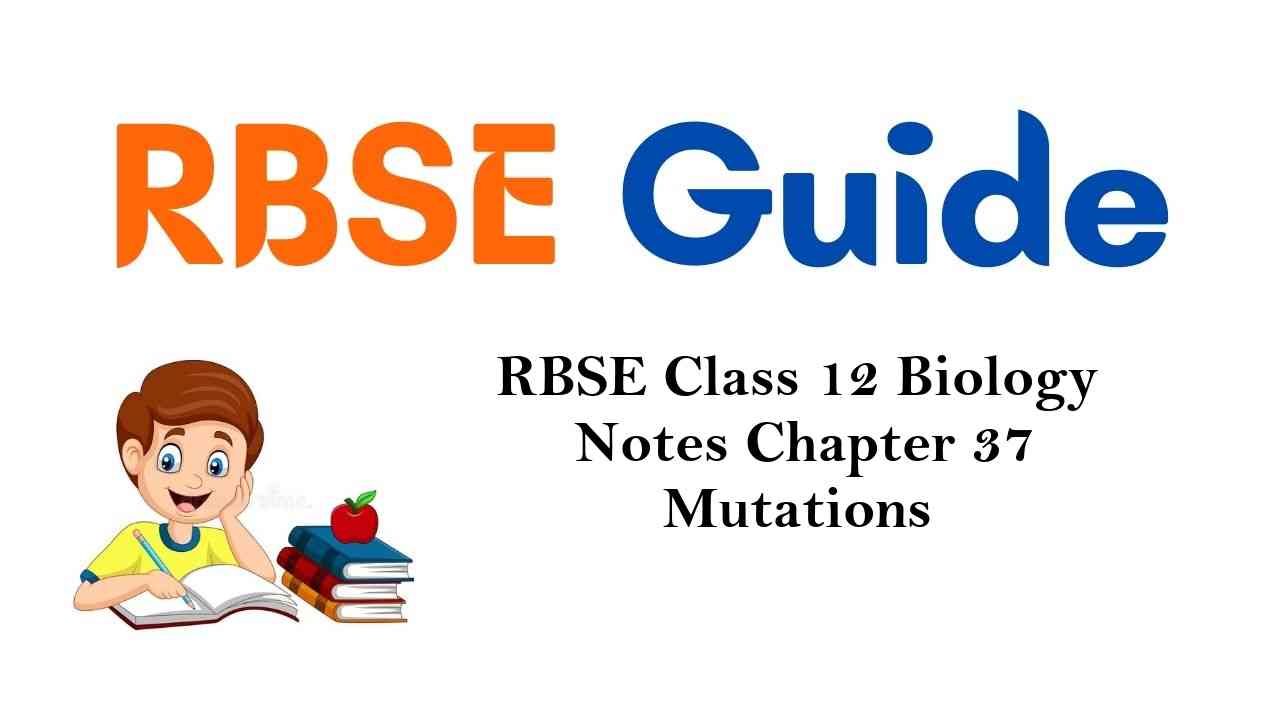Rajasthan Board RBSE Class 12 Biology Notes Chapter 37 Mutations
General
- The sudden changes in the hereditory material i.e. Chromosomes are termed as mutations.
- Hugo DeVries (1901) propounded “ theory of mutation”. It is based on the results of experiments on a plant, the evening primrose.
- De Vries explained that mutations are sudden changes and are the sole agent for evolution.
Mutations are always irreversible
![]()
Specialities of theory of mutations
- Mutations occur from time to time among the individuals of a naturally breeding species.
- The mutant organisms are markedly different from their parents
- Mutations are large, sudden & are heritable
- Mutations lead to the formation of new species.
- Mutations are both harmful & beneficial. The animals with harmful mutations are destroyed by natural seletion and the benefical mutations get established in the animals.
Types of Mutations
They are of two types:
A. Gene mutation
B. Chromosomal Mutation
Gene Mutation
General
- DNA replication occurs in meiosis which is a systematic process.
- Some time mismatch combination of nitrogenous bases occur in daughter DNA. If this change occurs at gene level it is known as Gene Mutation.
- It occurs at a particular locus of the chromosomes so it is also known as Point mutation.
- This kind of mutation occur due to replacement of nitrogenous bases it is also known as nucleotide pair recombination mutation.
- This modified gene behaviour is different from basic gene. These types of mutation occur frequently in the nature.
- The modified gene is called as mutant gene.
- Example : Sickle cell :Anaemia, white eyes in Drosophila.
Types of gene mutations
(A) Transitional Mutations :
In a transition mutation, a purine base is replaced with a purine base, or a pyrimidine base is replaced with a pyrimidine base. In other words, the base in the new nucleotide is in the same chemical class as that of the original nucleotide.

(B) Transversion Mutations :
In a transversion mutation, the chemical class of the base changes, i.e. a purine base is replaced with a pyrimidine base, or a pyrimidine base is replaced with a purine base.
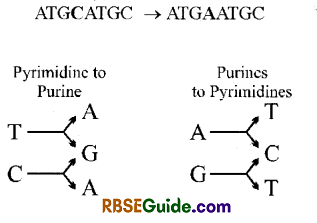
![]()
(C) Frame Shift Mutation :
Frame shift mutations are insertions or deletions nucleotides, hence the frame of the genes is changed. They are a subset of insertion-deletion (indel) mutations
that are specifically found in the coding sequence of polypeptides.
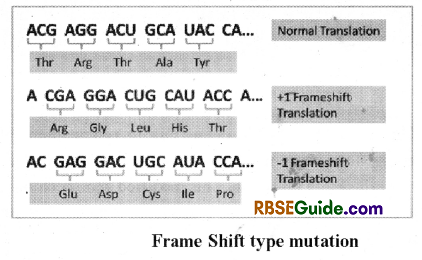
(D) Missense Mutation :
In genetics, a missense mutation is a point mutation in which a single nucleotide change results in a codon that . code for a different amino acid. It is a type of non synonymous substitution. Sickle cell anamia is an example of this type of mutation.
(E) Nonsense Mutation:
A nonsense mutation is a point mutation in a sequence of DNA that results in a premature stop codon, or a point- nonsense codon in the transcribed mRNA, and in a truncated, incomplete, and usually nonfunctional protein product.
![]()
Protein synthesis is blocked as UAAis a Stop codon.
(F) Silent Mutation :
Silent mutations are base substitutions that result in no change of the amino acid or amino acid functionality when the altered messenger RNA (mRNA) is translated. For example, if the codon AAA is altered to become AAG the same amino acid – lysine will be incorporated into the peptide chain.
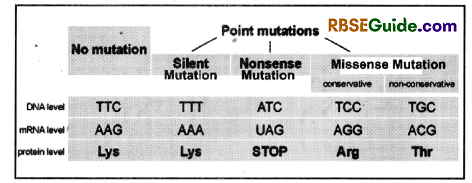
Salient Features of Gene Mutations
- They are sudden and indefinite changes.
- Gene can be mutated many times.
- Gene mutation is unidirectional. It can be changed completely and vice versa also.
- All organisms having some genes which are mutated forms of original genes.
- Many mutations are dominant in nature which changes the phenotypic character of living organisms. However, there are certain mutations which are recessive in nature and do not affect the characters of organisms.
- Generally mutations are deleterious for organisms. Because cell structure is very much complex and any change in genetic material become harmful or lethal.
- Due to dominant mutation cells, die at the early stage. So these genes are not available for long time. While recessive genes exist for a long period of time, as cell does not die because of mutation.
![]()
Factors affecting or Inducing mutations
Those substances which induce any kind of change in cell are known as Mutagens. They can be of following types.
- Ultra violet rays
- Radioactive rays (α, β, γ)
- Neutron and Protons
- Chemical Mutagens like Mustard Gas, Actinomycin D
- Increase in Temperature increases mutation rate.
Rate of mutation are affected by many factors. There are some mutagens which induce mutation in organisms. Muller in 1927, worked on Drosophila using X ray. He got a noble price in 1946 for his experiment.
Chromosomal mutation or Chromosomal aberration or Numerical changes in chromosomes
Any change in gene arrangement or insertion of a gene or deletion of a gene then these changes are known as Chromosomal Mutation.
They are of two types :
- Change in the number of chromosomes
- Change in the structure of chromosomes
Change in number of chromosomes
It is of two types :
(A) Euploidy or Polyploidy
The total set of number of chromosomes in cell or organism is called as monoploidy. The gaining of one or more complete sets of chromosomes is called as euploidy.
This can be of two types:
(a) Autopolyploidy
It is type of euploidy, where the additional set of chromosomes is derived from a parent or identical parental species.
For example, Triploid, Tetraploid, Pentaploid etc. Colchicine which is isolated from the com of Colchicuma autumnale has a ability to destroy spindle fibers during cell division so that the chromosomes do not move to the respective poles and ultimately chromosome number gets double.
(b) Allopolyploidy
In this type more than two haploid sets of chromosomes .that are dissimilar and derived from different species are added.
Example : Raphnobraccia (2n=36). Russian scientist GD. Carpichakof 1927) make a cross between Raphanus sativus (Radish) and Brassicct oleracea (Cauliflower);. It is sterile.
Triticale is a cross product of Triticum (wheat) and Secale (Rai) is also used as man made cereal “Triticale” and is commercially exploided all over.
(B) Aneuploidy
Aneuploidv is the addition or loss of one of more chromosomes to the complete diploid chromosome complement of an organism. It is caused by non-disjunction of chromosome during segregation of chromosomes.
It is of two types :
(a) Hypoploidy :
Hypoploidy is the loss of one or more chromosomes from the diploid genome. If there is loss of one chromosome (2n-l), it is called monosomy and if loss of pair of chromosome (2n-2), it is called Nullisomy.
(b) Hyperploidv.
Addition of one or more chromosome it is called Hyperploidy.
Excess of one chromosome is called as trisomy. Example—Down’s syndrome or 21st trisomy or Mongolism or Mongoloid Idiocy. (2n + 1)
Excess of two chromosomes is called as tetrasomy (2n + 2).
![]()
Structural Changes in Chromosomes.
These mutations result in structural changes in the chromosome. Hence, original structure of the gene is changed.
They involve changes either in the total number of genes or gene loci in a chromosomes or their rearrangement.
They are of 4 types
(A) Deletion :
It is a simplest kind of chromosomal aberration.
The deletion is loss of chromosomal segment.
Terminal deletion refers the loss of a segment from one or the other end of the chromosome.
Intercalary of Interstitial deletion involves at intercalary segment of the chromosome with the reunion of terminal segment.
(B) Translocation :
It is a type of chromosomal aberration.
A chromosomal segment goes to another chromosome (Unilateral) or normally, exchange of chromosomal segment (genes) between two non-homologous chromsome (Bilateral).
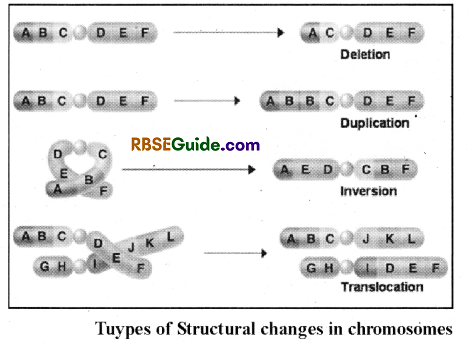
(C) Inversion
Some times the number of genes in a chromosome does not changed but the sequence of genes is altered by the rotation of chromosoma l segment within the chromosomes by 180°. Due to these change, genotypes remains unchanged but phenotypic characters change.
(D) Duplication
Sometime, some genes are present more than once in a chromosome i.e. one, segment repeats twice in a chromosome. It is called as duplication.
Genetic code :
General
- mRNA molecule encloses a genetic message for the protein synthesis. This mRNA controls protein synthesis by directing the arrangement of amino acids sequence.
- mRNA is formed from DNA by transcription. Hence, the gentic message present in mRNA is decided by the DNA
- The genetic message in mRNA is fnund in the form of sequence of nucleotides (bases) which is called as genetic code.
- Information regarding protein synthesis is located in the form of nucleotides sequence in DNA. It was discovered by Nirenberg, Mathais Ocho in 1968.
- Genetic code is a sequence of nucleotides which code for a polypeptide. The part of the gene which is responsible to produce polypeptide is known as Cistron.
Features of Genetic Code
- A codon of the genetic code is made up of 3 nitrogenous bases. (Triplet codon).
- There is no punctuation between adjacent codon, i.e. the genetic code is commaless.
- The genetic cod is non overlapping.
- The genetic codes are ambiguity in nature. It means a particular amino acid can be coded by more than one codons.
- It was explained by Crick who gives Wobble hypothesis. According to this theory, if the amino acid is coded by more than one code than initial two nucleotides of the codon are same only 3rd nitrogenous base are different.
- The genetic code is universal.
- AUG is an Initiation or starting codon which code for Methonine.
- UAA, UAG, UGA are Stop codon or Terminating codon. They donot code any amino acid. Hence, are also called as Non sense codons.
- The genetic code is read by mRNA at the time of protein synthesis.
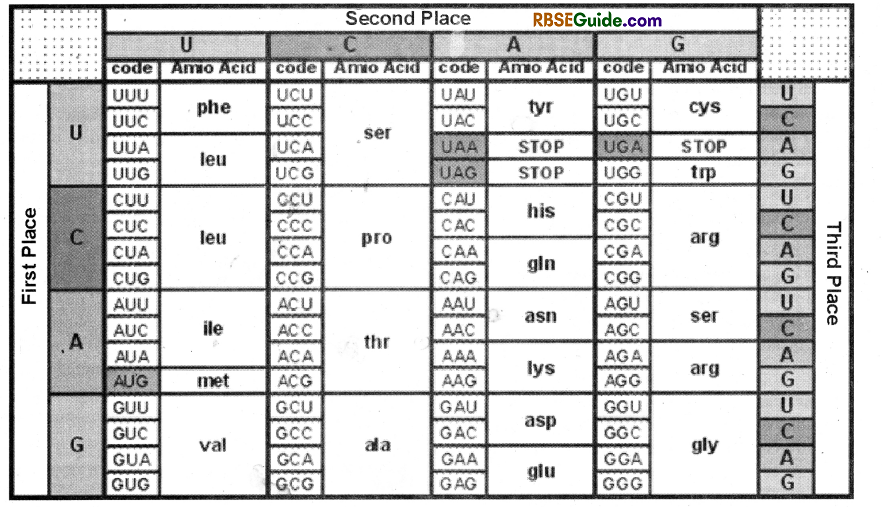
Human genome project :
General
- It is a scientific project which was aimed to study the complete sequence of the human genome. Genes are the key which decide how we appear and work. Moreover, the genes indicate our history and future.
- DNA sequence is different in two individuals at certain location, this promotes the scientists to completely sequence a human genome.
- The haploid set of chromosomes in a cell is called as Genome.
![]()
Human Genome Project
- The human genome project (HGP) is a project to map and sequence the 3 billion nucleotides contained in the human genome and to identify all the gens present in it.
- It is under the control of an international body, Human Genome organization (HUGO). This project was started in 1988 by US department of Energy (DOE). The DOE and National Institute of Health (NET) hand in hand started this project in 1990.
- 250 laboratories from 8 countries were involved in this project.
- James D. Watson was the leader of project and it was started under the leadership of Francis Collins. This is also called Mega Project & it was completed in 2003.
Aims of Human Genome Project
- To identify one lakh genes in human DNA
- To determine the base sequence of 3 billion chemical base pairs that makes up human DNA ,
- To store this information in database
- To improve tools for data analysis
- To address the ethical, legal and social issues that may arise from the project
- To determine the sequence of several modal organisms like E. coli, Yeast, ‘Drosophila , rat (Mus musculus)
Technique used in Human Geonome Project
There are two types of approaches for analyzing the genome
(A) Identify’ all the genes that are expressed as RNA Expressed sequence tags or ESTs
(B) Sequencing the whole genome (both coding and non coding regions) and later assigning the different regions with functions -Sequence annotation.
Second methodology was used in the HGP which involves following steps :
- The whole DNA of the cell is isolated and broken randomly into fragments,
- They are inserted into specialised vectors like BAC
(bacterial artificial chromospmes) and YAC (yeast artificial chromosome). - The fragments are cloned in suitable hosts like bacteria and yeast. PCR (polymerase chain reaction) can also be used for cloning or making copies of DNA fragments,
- The fragments are sequenced as annotated DNA sequences (an offshoot of methodology developed by double Nobel laureate, Frederick Sanger), Sanger used Di-deoxy Chain Termination method through advanced DNA sequences.
- The sequences were then arranged on the basis of some overlapping regions. It necessitated the generation of overlapping fragments for sequencing,
- For physical and gentic mapping of sequence recognition sites of restriction endonuclease are used which are located on microsatellite of the chromosomes. Sequencing of overlapping end is done through special sequence program through computer.
Salient Features of Human Genome
1. Human genome has 3.1657 Billions nucleotide base pairs.
2. According to presumption of human gene from 80,000 140000 but HGP revealed the Number of genes has 30,000.
3. The average gene size is 3000 base pairs. Dystrophin is the biggest gene, contains 2.4 crores base pairs.
4. Human Genome project revealed Single Nucleotide polymorphism (SNP). At 104 million places this SNP is found. It helps in identifying sequence for disease on chromosome.
5. Function of 50% genes have been identified.
6. Fess than 2% genes are involved in protein synthesis.
7. Chromosome Number 1 has highest gene number which is 2968 genes and lowest number of genes are present in Y chromosome which only 231 genes.
8. 99.9% of the nucleotide bases are exactly similar in all human beings.
9. Only 0.1% of human genome with some 3.2 million nucleotides represents the variability observed in human beings
10. Repeated or repetitive sequences make up a large portion of human genome. There are some 30,000 minisatellite loci, each having 11 -60 bp repeated randomly up to thousand times. These are about 2,00,000 microsatellites, each with up to 10 basic pair repeated 10-100 times.
11. Repetitive sequences are nucleotide sequences that are repeated many times, some-times hundred to thousand times. They do not have direct coding function but provide information as to chromosome structure, dynamics and evolution.
![]()
DNA Fingerprinting
Human are identified by their names and their characteristic. No two organisms have similar characteristics, (except identical twins).
There are certain characteristics such as skin colour, hair colour, colour of pupil of eye, height, voice, pattern of walking, sitting, way of talking, way of living through which we can differentiate or identify two individuals.
Every individual differs in finger prints.
There is difference in imprints and pretine we observe, is called finger print. This is actually a official way of identification of an individual. It was developed by Francis-Galton, which is still in use.
Alec Jeffreys & colleagues (1985) were investigating a DNA fragment from the gene for a human blood protein, globin. They discovered that this fragment contained a sequence of bases repeated several times.
This repeated DNAis called as minisatellite. Further, same minisatellite sequence was found in other places in human genome repeated several time. More interestingly, the individuals differ in the pattern of repeats of the base sequence & they differ enough that two individuals have only a remote chance of having exactly the same pattern. That means that these patterns are lile fingerprints & are called by Jeffreys as DNA fingerprints.
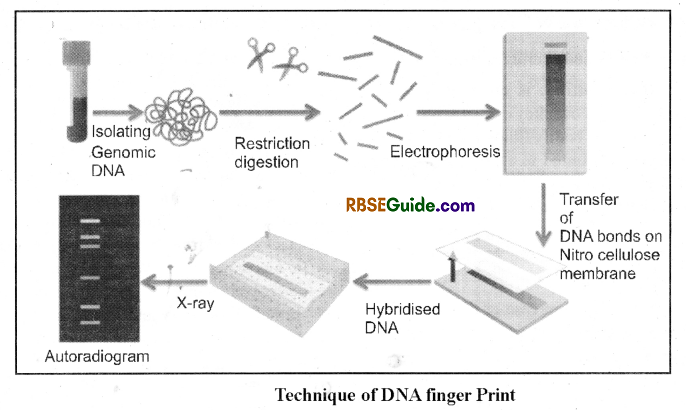
Principle
Several small nucleotides are found repetitively in DNA. They are called VNTRs (Variable Number of Tandem Repeats). The length to VNTR of two persons may be of same length but sequence will be different.
In every child half of the VNTRs come from mother and other half comes from father.
DNA finger printing Technique
1. DNA is isolated from the source material like drop of blood, saliva, semen, teeth etc. by help of high speed Refrigerated centrifuge.
2. If DNA is less in amount it should be amplified using Polymerase Chain Reaction (PCR).
3. DNA is cut into fragments using restriction endonuclease enzyme for Restriction Fragment Length Polymorphism (RFLP).
4. These fragments are poured into separate wells of an electrophoresis gel and electrophoresed. These fragments are stained with fluorescent dyes like Ethidium Bromide and observed under UV light.
5. Alkaline solutions changed these double stand DNA into single stand DNA. This process is known as Denaturation.
6. The separated DNA fragments are transferred to a nitrocellulose membrane by placing it over the gel. This process is called Southern Blotting.
7. These nitrocellulose membrane are placed in DNA probe solution where probe bind with appropriate minisatellites and forms duplex DNAs. Probe contain specific nucleotide sequence which are complementary’ to VNTR sequence. Probe hybridise with VNTR sequence if found complementary.
8. W hen this Probe containing nitrocellulose membrane is exposed to X-ray irradiation. Dark Bands are formed on X-ray film where basis of Probes has hybridised or made bond with DNA strands on membrane.
9. Now these bands are compared with other bands, whom we leave to compare.
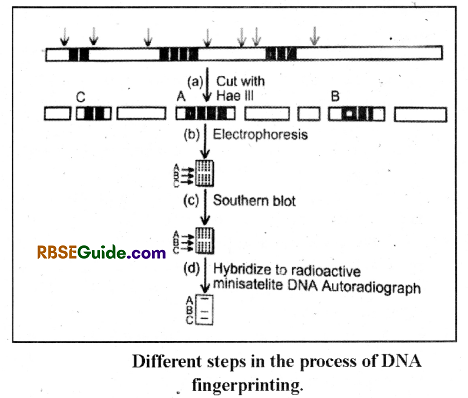
![]()
Application ofDNA Fingerprinting
1. In Criminal cases and Family affaires :
DNA fingerprinting, is commonly used in forensic cases to undercover key evidence for criminal trials. In crime scenes, bodily fluids such as blood are taken as samples and tested in a lab to help identify the DNA of individuals who might have contributed or were the victim of the crime. For this technique biological wastes such as blood may be dried, semen, hair, tooth, a piece of bone, any body tissues etc. is obtained at the site of crime.
This technique is also used in case of disputed parents where DNA of probable parents are tested against child DNA and help in identification of actual parents.
This technique is also helpful in Murder, rape, crime, property nomination, divorce cases. Where identification of parent is very important. Every individual has received DNA from its parents and can be identified by help of VNTRs.
2. Medical Field
Several hereditary diseases can be detected at the early stage of pregnancy. It can be managed at certain level through DNA finger printing.
3. It is used to assess the pattern of migration of ancient populations.
4. It is also employed in the genetic analysis of various strains of agricultural crops and animals.
5. It is also employed to understand evolution.
Cloning
General
A group of cells or organisms which originate from one parent cell/organism and which are similar physically and genetically to the parent are called as clone. The process of formation of clone is called as cloning. [G Klon => cutting used for propagation]
In simple organisms, the cloning is found in natural way. But it is lacking in higher animals.
Identical Twins are also like clones as they are formed by first division of a single zygote so these two divided cells grow individually and develop into complete separate embryo.
In plants tissue culture technique is used to make plants. In tissue culture technique single cell from desired plant is cultured in suitable medium
For animal cloning nuclear transfer technique is used. The steps involve removing the DNA from an oocyte (unfertilized egg), and injecting the nucleus which contains the DNA to be cloned.
By various experiments, scientists came to conclusion that the capacity to form a complete organism from a single cell lies with egg.
In 1969, J.B. Gurdon successfully cloned a frog using intact nucleus from the somatic cell of a Xenopus tadpole. In his experiment nucleus of unfertilized egg was destroyed using UV rays and nucleus of intestinal epithelial cell was introduced in it. so the developed tadpole are identical to their parents.
![]()
Types of Cloning
Cloning is of three tyeps :
Gene Cloning :
The production of a large population of a DNA fragment in pure from is called as gene cloning. It involves formation of recombinant DNA and its introduction into the mother bacterial cell. The recombinant DNAis formed by combining DNAs from two different organisms. This process is called as genetic engineering.
A DNA fragment of one organisms (called as Passenger DNA) is transferred into another organism by combining it with another DNA (called as Vehicle DNA). Normally plasmid or bacteriophase DNA is used as Vehicle DNA.
Both the passenger and vehicle DNA are cleaved by using restriction endonuclease enzyme and they are mixed under suitable conditions. Their complementary sticky ends pair and their ends are sealed by ligase enzyme. The resulting DNA is called as recombinant DNA.
The recombinant DNA, is added to the culture containing growing host bacteria. These bacteria take the recombinant DNA along with the nutrients. This DNA replicates when the bacteria divide and produce a large clone of recombinant DNA.
Cell cloning
Both the prokaryotic and eukaryotic organisms which can live in nature as single cell can easily be cloned invitro. The clones of the animal cells can also be obtained from their cell suspension. A small number of cells are added to a culture medium which proliferate and produce clones of identical cells within a week.
Animal Cloning
In this cloning entire animal is cloned. There are 3 ways of animal cloning :
(A) Blastomere separation :
When fertilization takes place through sperm and ovum, zygote is formed. These zygote cleaved and make blastomere cells. Blastomere cells are capable to produce embryo. This type of cloning is known as Twinning and technique is known Embryo Cloning.
(B) Nuclear Transfer Technique :
In this technique, clones are made without fertilization. The nucleus of an oocyte (egg cell) is removed and is replaced with the nucleus of a desired cell. The cell contains genetic information identical to the donor cell. After stimulating this cell. It begin dividing and develop embryo.
This technique was used by Dr. Ian Wilmut & Collegues of Rosalin Institute, Scotland to develop a clone of sheep “Dolly” in 1996.
![]()
(C) Honolulu Technique :
The technique is accredited to Teruhiko Wakayama and Ryuzo Yanagimachi of the University of Hawaii in 1998. Mice had long been held to be one of the most difficult mammals to clone due to the fact that almost immediately after a mouse egg is fertilized, it begins dividing. Wakayama initially used three types of cells, Sertoli cells, brain cells, and cumulus cells.
Sertoli and brain cells both remain in the G state naturally and cumulus cells are almost always in either the Go or Gt state. This technique is based on Garden technique where donor nucleus is transferred to enucleate egg cell. By this technique he announced to have developed 50 mices. His first cloned mice was ‘annulus’ he cloned this mice up to three generation which proved that cloning does not produces any abnormality.
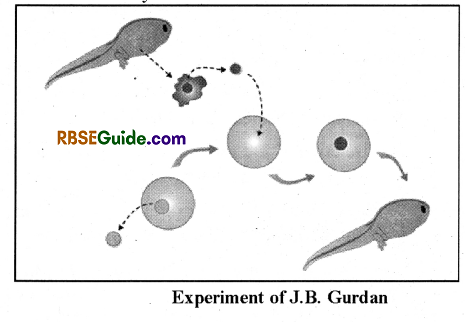
Process of Cloning of Doly.
Ian Wilmut and coworkers in (1995) prepared Magon and Morgan clones of sheep by nuclear tranplantation from sheep embryo into sheep ovum at Roslin Institute, Scotland. In Feb 1997, Ian wilmut has produced a clone of adult lamb named “Dolly”. Further, in July 1997, Ian Wilmut and coworkers prepared sheep clones called Polly and Molly. These clones were created from a single cell taken from the udder of an adult sheep. The complete procedure is shown in fig.
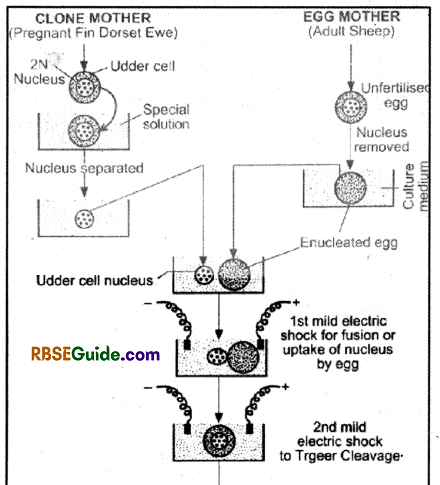
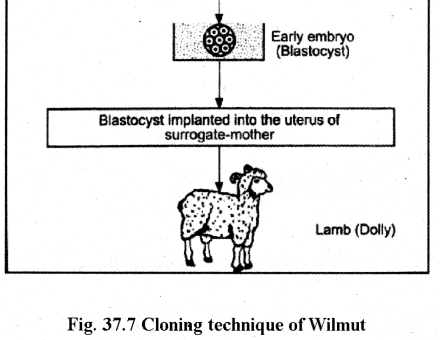
Noori is a female pashmina goat, the first pashmina goat to be cloned using the process of nuclear transfer was developed by the joint collaboration of Sher-e-Kashmir University of Agricultural Sciences and Technology of Kashmir and National Daily’ Research Institute, Kamal. Under financial support from World Bank. She was bom on 9 March 2012 in Kashmir. Noori word taken from Arabic word which means light. Pashmina Goat is found in Cola regions whose wool is very costly.
![]()
Application of Cloning
1. Therapeuted cloning : When anys organ is damaged inhuman or in many diseases such as leukaemias, liver damage, Parkinson’s, Alzheimey’s disease, disease, heart & kidney disorders, replacement of damaged organ with another one is useful, for making available these organs. They can be produced by cloning.
2. Improvement in Animals with desired characteristics (Transgenic Organsims).
In this process the improvement in genatic resources can be done in agriculture related organism. Important or useful gene from human or other organism is used in improvement of variables of organisms (by transferring gene into them). These organisms are known as Transgenic organisms. By cloning technique various transgenic animals have been produced with properties like increased milk yield, wool and flesh (meat).
3. Genetic engineering technique (Gene therapy). Genetic disorders can also be treated with help of cloning or genetic engineering technique.
4. By help of cloning, we can produce. Herbicide resistant, insect resistant, high salinity tolerable plants and with increased production crops.
